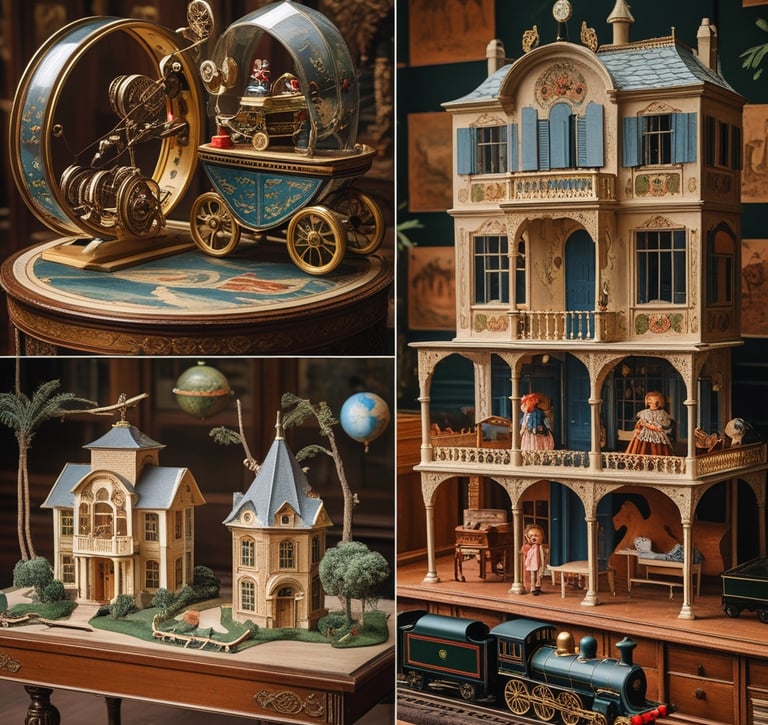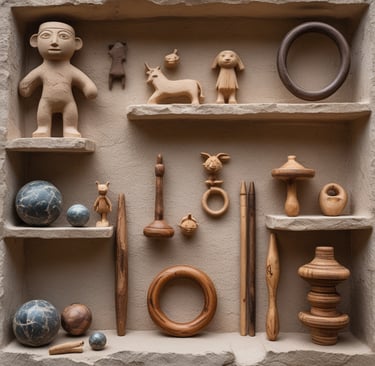The Evolution of Toys Through History: From Ancient Amusements to Modern Marvels
Toys hold a timeless charm, bridging generations with their universal language of play. They are not just objects; they are companions, teachers, and windows into the eras they emerge from. The history of toys mirrors the evolution of human creativity, culture, and technology. Let’s embark on a nostalgic journey through the ages, exploring how toys have evolved while connecting them to the innovative options available today.
5/8/20244 min read


Ancient Beginnings: The Origins of Play
The earliest toys date back to ancient civilizations, where they were handcrafted from natural materials like wood, clay, and stone. These toys were simple yet ingenious, serving as both entertainment and tools for skill development.
4000 BCE (Ancient Egypt): Archaeological discoveries have unearthed clay animal figurines and marbles. These early toys reflected the environment and daily life of children at the time.
2000 BCE (Ancient Greece and Rome): Spinning tops, hoops, and knucklebones (similar to modern jacks) were popular. Dolls made of wood or ivory were cherished possessions, often buried with their young owners as a sign of affection.
Play’s Purpose: These early toys not only entertained but also prepared children for adult roles. For example, miniature weapons and tools introduced kids to hunting and farming.
Today’s Connection: Modern toys like wooden blocks or clay modeling kits echo the tactile, skill-building nature of these ancient amusements.
The Middle Ages: From Simple to Symbolic
During the medieval period, toys took on more symbolic roles, reflecting the social hierarchy and craftsmanship of the time.
Handmade Treasures: Most toys, such as carved wooden animals, spinning tops, and simple dolls, were handcrafted by family members or local artisans.
Education Through Play: Chess and dice games emerged, teaching strategy and critical thinking.
Gendered Play: Toys often mirrored societal norms, with boys receiving toy swords and girls playing with dolls.
Today’s Connection: Board games and role-play toys, like action figures and dollhouses, carry forward these traditions while breaking free from restrictive gender norms.
The Renaissance and Enlightenment: A Burst of Creativity
he Renaissance ushered in an era of innovation, and toys became more intricate and widely available. The burgeoning middle class spurred the growth of a toy-making industry.
Clockwork Wonders: Mechanical toys, like wind-up birds and carriages, fascinated children and adults alike.
Miniature Worlds: Elaborate dollhouses and model trains captivated young imaginations.
Global Influences: Trade introduced toys from different cultures, enriching playtime with diversity.
Today’s Connection: Today’s tech-driven toys, such as robotics kits and interactive dolls, can trace their roots to these early mechanical marvels.
The Industrial Revolution: Play Goes Mainstream
The Industrial Revolution transformed the toy industry, making toys more affordable and accessible due to mass production.
Materials Revolution: The introduction of rubber and tin allowed for more durable and innovative toys.
Classic Creations: Iconic toys like the teddy bear, rocking horse, and yo-yo became household staples.
Toy Stores: Dedicated toy shops emerged, creating a new cultural phenomenon around gift-giving and holidays.
Today’s Connection: The mass production of toys set the stage for today’s globally loved brands, from LEGO sets to Hot Wheels cars.
The 20th Century: A Golden Age of Toys
In today’s digital age, toys that encourage screen-free, active play become even more important. Such toys inspire focus and mindfulness, steering children away from passive consumption of media. This screen-free engagement promotes healthier brain development and helps build stronger attention spans.
Smart Toys: AI-powered companions like Cozmo and educational robots like Coding Critters make learning fun.
Video Games: From consoles to mobile apps, video games have become a dominant form of entertainment for kids and adults.
Virtual Reality (VR): VR headsets transport children to imaginative worlds, offering immersive gaming and educational experiences.
While these innovations are remarkable, there’s a renewed appreciation for traditional toys that encourage screen-free play, such as puzzles, board games, and outdoor toys.






The 20th century saw an explosion of creativity, influenced by advances in technology, media, and marketing.
Early 1900s: Simple wooden and tin toys remained popular, but the introduction of electrical toys, like toy trains, changed the game.
1950s and Beyond: The post-war economic boom gave rise to iconic toys like Barbie, Play-Doh, and Mr. Potato Head. Television brought characters like Mickey Mouse and G.I. Joe into children’s playrooms.
Plastic Revolution: Lightweight and versatile, plastic became the material of choice for most toys, paving the way for everything from building blocks to action figures.
Today’s Connection: While nostalgic classics like Barbie and LEGO continue to thrive, modern iterations incorporate technology, such as app-connected dolls and augmented reality games.


The Digital Era: The Rise of Tech Toys


